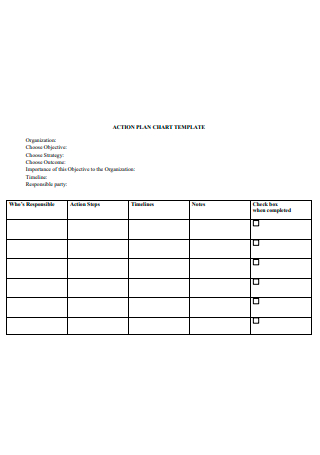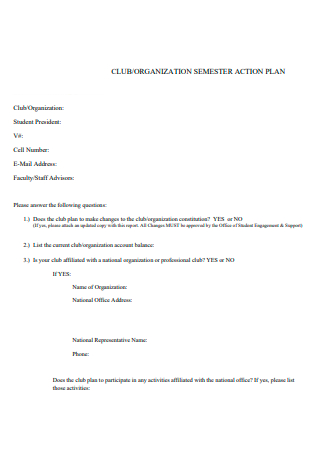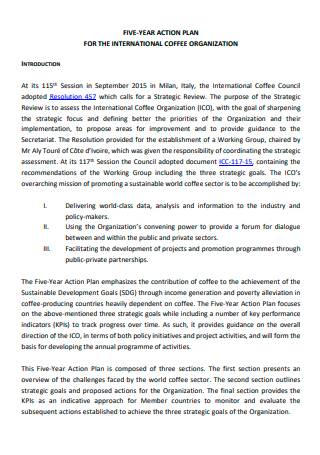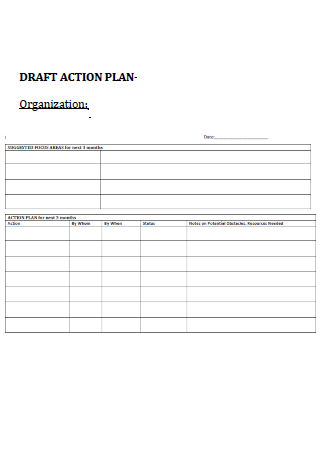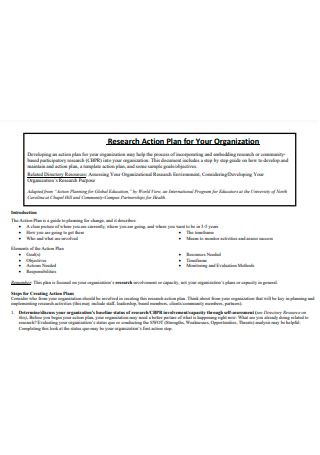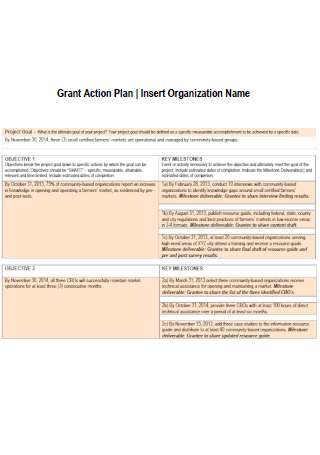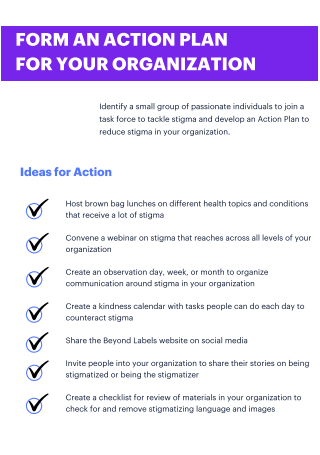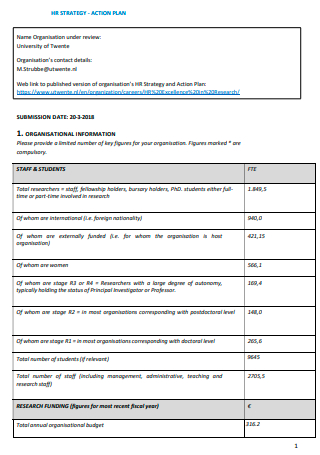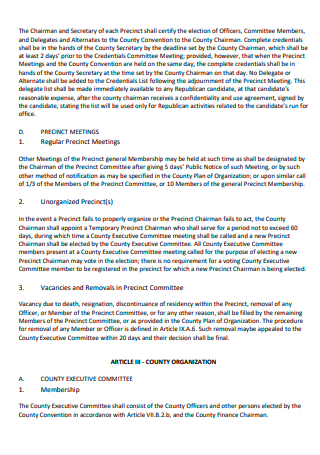11+ Sample Organization Action Plan
FREE Organization Action Plan s to Download
What Is an Organization Action Plan?
An organization action plan is a plan that details the strategies and projections of any structured, hierarchical group. It could involve a company, corporation, community, or essentially any group that shares a common goal or mission.
According to an online article by the Association for Talent Development, organizational development is a key area in business that entails the constant improvement processes of aligning strategies, plans, structures, and human resources to further an organization’s performance. The five phases needed to execute an organization development strategy are entry, diagnosis, feedback, solution and evaluation.
Types of Organizations
There are all kinds of organizations with various end goals and purposes. Some of the most common ones are listed below.
Student Organizations: Schools, especially institutions with a big student population, are fertile ground for all kinds of student-led organizations. Joining organizations and clubs can be a huge influence and significant part of a student’s campus life. Universities and colleges have all types of organizations that cater to different needs and advocacies. For example, there are socio-civic driven groups or clubs that seek to push agendas that benefit the common good or target a particular marginalized sector of society. There are academically-inclined clubs that supplement students’ education, interest-based groups that bring together people with the same hobbies and passions, and service-oriented or support groups that simply give the student an opportunity to be part of something. Non-government Organizations: NGOs or non-profit organizations are known for their supplemental help and work they do to the broader society. Some people see non-government organizations as the other major pillar of society that fill the gap which governments or states are unable to fill or are lacking in. This is why many nonprofits are usually targeted at improving the lives of people and their communities. They are socially-oriented and are often cause-driven. Further, non-government organizations are sometimes seen as foundations or charities wherein donations and sponsorships help maintain the organization’s operations. Government Agencies: A state has different functions and multiple arms or branches, with each arm serving a specific purpose. Nation states can have numerous posts, offices, and agencies- depending on the type of government. These are highly bureaucratic and a strict hierarchy is typically followed. In democratic governments, there can be hundreds of organizations, each serving its own purpose to deliver services and legislation to a country’s citizens. Like a body with multiple organ systems, a government is made up of micro parts that contribute to its whole as well. Not only do these parts and agencies serve a greater purpose, they make up an entire country’s governing system in which without them, nations would not even be able to function. Religious Organizations: Apart from the state, religion also plays a key role in societal functions. For centuries, religion has dictated the way people live and interact with one another. Organized religion from Judaism to Buddhism to Christianity, subscribe to a set of beliefs and practices that have inspired and continue to inspire millions-if not billions- of people each day. But part of the broader aspect of organized religion is it allows people to be part of something that is much larger and greater than themselves. A sense of belonging is evident in church groups, prayer meetings, worship services, bible studies, and in religious sacraments and traditions. For the outsider, one cannot doubt the power religion has had over people in every era and every generation in history. Civic Organizations: Civic organizations such as the Rotary Club or Toastmasters Club, offer an alternative to non-government organizations. Both have certain similarities but may also differ in terms of purpose and strategy. The state and Church are two institutions that have long been considered the most fundamental institution in a majority of societies. Along with the media, civic groups and civil organizations have members that are not merely bound by common interest, but they make it their mission to serve the same way governments and religious organizations are supposed to. Many of these civic groups are service-oriented and driven by their will to make an impact in the lives of people. Labor Unions: If schools and universities have student organizations, fraternities, and sororities, workplaces and companies have unions. Thanks to decades of struggle in the past, employees today are given a voice and the freedom to organize themselves in order to protect their rights and interests. Labor unions are vital organizations because they not only help promote the rights of the worker, but also serve as a platform for concerns to be heard and recognized. Unions provide an opportunity and space for proper dialogue to exist between employers and employees.
Tips When Drafting an Organizational Action Plan
Creating a comprehensive and effective organization action plan takes a lot of effort and brainstorming. However, there are several things you can do to make sure your action plan is as impactful and dynamic as can be. Keep in mind the following tips when crafting your organization action plan.
Look Ahead: By their very nature, plans are future-oriented. People do not make plans for things and events that have already happened. An action plan requires an intentional act of preparing and looking ahead. If you are an organization, that means you are not only responsible for the future of a an individual or a small group of people. You are responsible for the direction of all people within the organization. Plans like a three, five, or even ten year plan are such examples. It is important for companies and organizations to think long-term in their plans, otherwise what would be the point of development and growth? Be Concrete: It is important to be specific whenever it comes to action plans. For organizations, make sure to cite concrete objectives and goals. Plans need to consist of measurable, definitive steps in order for it to be called a plan. What do you want to achieve as an organization? What steps could possibly lead your organization to accomplish its goals? Describe these action steps and try to explain it in the most detailed way possible. What would be the point of an organizational action plan if it were not based on action or doable, tangible acts. Assign Accountability: For an organizational action plan to be properly executed, there needs to be an element of accountability and responsibility. An organization is not just one person but a collective group of people. The success or failure of one will profoundly affect the rest of the organization. With this in mind, it makes it all the more critical for accountability to be established. To avoid pointing fingers and playing the blame game, make sure to assign specific tasks and roles to the right people. Set Targets: An important tip to remember when making an organization action plan is to set targets. And not only targets in the same way objectives and goals are defined, but actual numberical targets and figures. Incorporating measurable numbers and rubrics in your plan makes it more concrete too. With hard figures and fixed targets, your organizational action plan is less ambiguous and abstract. Brainstorm as a Team: Drafting an organization action plan requires combining the best ideas and coming together as a team. There must always be a collaborative effort when it comes to strategic planning. The more minds and ideas are put together, the higher chance there is of a richer and successful overall action plan. The simple act of brainstorming as a group where ideas are bouncing off other people, will prove to be more beneficial than if only one person is contributing his or her ideas.Be Realistic: It is good to maintain a sense of idealism when it comes to creating action plans; however, it is equally important to keep grounded in reality as well. You want to make sure that you are able to conduct a realistic assessment of not just the organization’s strengths, but also its weaknesses. Evaluating these important facets of an action plan is absolutely critical. In order to realize this, an open perspective is required. In the same way, a rational assessment of the opportunities and threats that your company potentially faces may also be very helpful. Putting it all together, a deeper SWOT analysis can make your action plan more grounded in reality.
How to Create an Organization Action Plan
Save time and energy by using a ready-to-use action plan template from above. This way, it is easier to follow the steps below.
Step 1: Identify the Objectives
What are the goals of your organization action plan? You can enumerate these objectives and goals in clear bullet points. Identify the purpose of why you are drafting an organization action plan in the first place. Your objectives set the direction of your plan of action. Keep it brief but specific as well. Try to use descriptive words and action-oriented language when listing all your objectives.
Step 2: Determine the Actions to be Taken
An action plan requires action, obviously. You need to be able evaluate and specify the best course of action for the organization. It may take some substantial research and broad discussion, but weighing the options is a key part of the process. Make sure to arrange your action items in an organized manner too. These can be in the form of a table or a flow chart, it would entirely depend on the organization and its leadership.
Step 3: Assess the Available Resources
Another important aspect of an organization action plan is evaluating the organization’s current and available resources. This is a crucial step because it can help chart the organization’s long-term action plan. If an organization has a greater awareness of its own capacity and resources, there is a much better chance of creating a more realistic and credible plan of action. Resources can mean anything from manpower, capital, infrastructure, network, technology, etc.
Step 4: Set a Timeline
Timetables are important components of any organization’s action plan. It is for the same reason why deadlines and due dates are needed. They are needed to get things done; not merely for the sake of getting it done, but to ensure constant progress and safeguard productivity. The absence of a clear timeline or timetable may undermine progress or allow complacency to take root. With every action item or strategy in your organization action plan, you need to make sure that a corresponding timeline is given to each item.
FAQs
How do you write an action plan for an organization?
To write an effective action plan for an organization, you need to start with an honest reflection of your organization’s objectives and goals. From there, you can begin to outline the action steps that need to be taken in order to realize those goals. In addition, you need to include other key elements as well, including timelines and persons responsible. Refer to the sample templates and tips above.
What is an action plan example?
Most action plans involve project management, marketing and branding, product launching and testing, communication, risk management, business development, costing and finance, and strategic planning.
What are the 7 steps in making an action plan?
According to an article by Baachu Scribble, the seven steps in creating an action plan for business strategies are the following: start with teamwork, delegate and define tasks and roles, set deadlines, ensure proper follow-up, practice transparency in communication, and be consistent.
Action plans are not only beneficial for individual and personal use. Organizations and companies can get a lot out of it as well. Developing strategies and charting an organization’s path are core processes of business. Browse the various sample templates above and get started on your own organization action template today!
